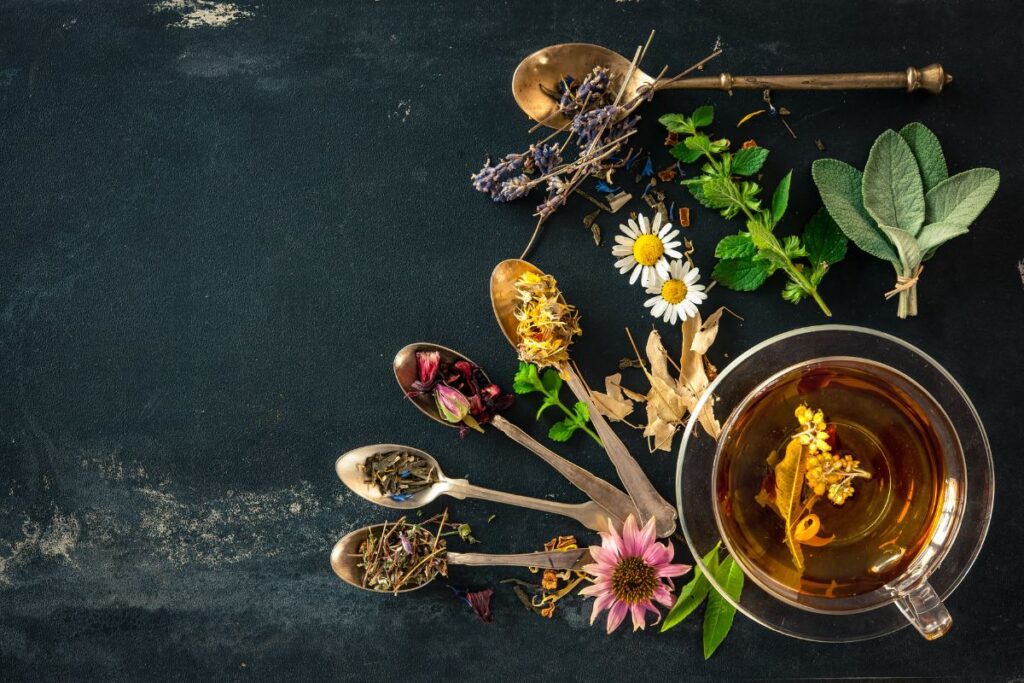Tips for Scaling Up Herbal Tea Blending for Private Label Production: Our Expert Guide
Herbal tea blending is a thriving business opportunity with immense market demand. As we scale up our herbal tea blending operation, we unlock the potential for increased profits and substantial growth.
To start, it’s crucial to conduct thorough research on ingredients and their benefits. By understanding the qualities of each ingredient, we can create unique blends that cater to diverse preferences. Building strong relationships with suppliers ensures consistent access to high-quality ingredients that meet our standards. Experimenting with different combinations allows us to develop new offerings that set us apart from competitors.
Creating an appealing brand image is also essential. Designing an eye-catching logo and developing a user-friendly website enhances our credibility and attracts customers. Offering samples to potential partners fosters trust and encourages collaboration. By working together with like-minded individuals or organizations, we can leverage their expertise and expand our reach.
Scaling up our herbal tea blending operation requires dedication, creativity, and a deep understanding of customer preferences. By implementing these tips, we can elevate our business to new heights in the competitive world of private label production.
Understanding the Herbal Tea Market
Conduct Thorough Market Research
Before scaling up your herbal tea blending for private label production, it is crucial to conduct thorough market research. This will help us understand current trends and consumer preferences in the herbal tea market. By gathering valuable insights, we can make informed decisions about our product offerings and marketing strategies.
Market research involves analyzing various aspects of the tea industry, including the demand for herbal teas, popular flavors and blends, and pricing trends. We can start by examining market reports and studies that provide valuable data on consumer behavior and preferences. These reports often highlight emerging trends and identify key growth areas within the herbal tea business.
Conducting surveys or focus groups with potential customers can provide firsthand information about their preferences and expectations. This qualitative data can complement the quantitative data obtained from market reports, giving us a comprehensive understanding of the target audience.
Identify Popular Herbal Tea Flavors and Blends
To effectively scale up our herbal tea blending for private label production, we need to identify popular flavors and blends that have high market potential. This requires a deep dive into different herbs used in herbal teas and their benefits.
Some popular herbs used in herbal teas include chamomile, peppermint, ginger, lavender, hibiscus, and echinacea. Each herb has unique properties that contribute to its flavor profile as well as potential health benefits. For example, chamomile is known for its soothing properties while ginger adds a spicy kick to blends.
By experimenting with different combinations of these herbs, we can create unique flavor profiles that cater to various consumer preferences. It’s important to strike a balance between traditional favorites like chamomile or peppermint while also offering innovative blends that appeal to adventurous tea enthusiasts.
Analyze Competitors’ Products and Pricing
Analyzing competitors’ products and pricing is essential for positioning our brand effectively in the herbal tea market. By studying what other companies are offering and at what price points, we can identify gaps in the market and find opportunities to differentiate ourselves.
We can start by researching both local and international tea brands that specialize in herbal teas. This will help us understand their product offerings, packaging designs, marketing strategies, and target audience. By identifying gaps or areas where our competitors may be falling short, we can tailor our products to meet those specific needs.
Pricing is another crucial aspect to consider. We need to strike a balance between offering competitive prices that appeal to consumers while also ensuring profitability for our business. Analyzing competitors’ pricing strategies will give us insights into market trends and help us determine the optimal price range for our products.
Identifying Your Niche and Target Customers
To successfully scale up herbal tea blending for private label production, it’s essential to identify your niche and target customers. This will help you differentiate your brand in the crowded market and tailor your tea blends to cater to specific customer needs and preferences.
Define Your Unique Selling Proposition (USP)
One of the first steps in identifying your niche is defining your unique selling proposition (USP). This is what sets your brand apart from others and gives customers a reason to choose your products over competitors’. Consider what makes your herbal tea blends special. Is it the use of rare or exotic ingredients? The incorporation of traditional healing practices? Or perhaps a commitment to sustainability? By clearly defining your USP, you can create a strong brand identity that resonates with your target audience.
Identify Your Target Customers
Once you have established your USP, it’s time to identify your target customers. Understanding who they are will allow you to tailor your marketing efforts and product offerings accordingly. Start by analyzing demographics such as age, gender, location, and income level. This will give you a basic understanding of who is most likely to be interested in your herbal teas.
Tailor Your Tea Blends
Now that you know who your target customers are, it’s important to tailor your tea blends to cater to their specific needs and preferences. Consider factors such as taste preferences, health benefits sought after, and lifestyle choices. For example, if you’re targeting health-conscious individuals, you may want to focus on blends that promote detoxification or stress relief. On the other hand, if you’re catering to those seeking indulgence and relaxation, you might develop blends with soothing flavors like lavender or chamomile.
By customizing your tea blends based on the desires of your target audience, you can create products that resonate with them on a deeper level. This not only increases customer satisfaction but also enhances brand loyalty and encourages repeat purchases.
Creating Your Own Tea Blends
Experimenting with Different Combinations
The possibilities are endless. We can experiment with various combinations of herbs, flowers, fruits, and spices to create unique and exciting flavor profiles. By blending different ingredients together, we have the opportunity to craft teas that are truly one-of-a-kind.
Focusing on Well-Balanced Blends
A good tea blend is all about balance. As we embark on our tea blending journey, it’s important to focus on creating blends with complementary ingredients. We want each ingredient to shine while also harmonizing with the others in the blend. This way, every sip will offer a well-rounded and satisfying experience.
To achieve this balance, we need to consider the flavors and aromas of each ingredient and how they interact with one another. For example, if we’re using a strong-flavored herb like peppermint, we might pair it with a milder herb like chamomile or lavender to create a more balanced blend. Experimentation is key here; don’t be afraid to try out different combinations until you find the perfect balance for your taste.
Incorporating Health Benefits into Blends
In today’s health-conscious world, consumers are increasingly seeking products that offer not only great taste but also potential health benefits. As herbal teas are known for their therapeutic properties, incorporating these benefits into our blends can attract a wider audience.
For instance, if we’re looking to create a calming blend, we might consider using herbs like chamomile or lemon balm known for their relaxing properties. On the other hand, if we want an energizing blend, herbs like ginseng or peppermint could be excellent choices.
By researching the health benefits associated with different herbs and including them strategically in our blends, we can appeal to those who prioritize wellness while still delivering delicious teas.
Sourcing Organic Ingredients and Drying Techniques
To ensure the highest quality herbal tea blends for private label production, it is crucial to source organic ingredients from trusted suppliers or consider growing them yourself. By choosing organic ingredients, we can guarantee that the herbs are free from synthetic pesticides, herbicides, and other harmful chemicals. This not only benefits our health but also supports sustainable farming practices.
When sourcing organic ingredients, it is essential to find reputable suppliers who prioritize quality and sustainability. Look for suppliers who have a strong track record in providing organic products and have established relationships with farmers who adhere to organic farming methods. By working with reliable suppliers, we can be confident in the authenticity of the ingredients we use.
In addition to sourcing organic ingredients, proper drying techniques are vital for preserving the flavor, aroma, and medicinal properties of the herbs. The drying process helps remove moisture from the plants while retaining their beneficial compounds. There are various methods for drying herbs, including air drying, oven drying, or using specialized dehydrators.
Air drying is one of the most traditional and cost-effective methods. It involves hanging bundles of herbs upside down in a well-ventilated area away from direct sunlight. This allows air circulation to dry out the herbs slowly while preserving their natural oils and flavors.
Oven drying is another option if you need to speed up the process. However, it’s important to keep the temperature low (around 100°F or 40°C) to avoid damaging delicate plant compounds. Spread out the herbs on a baking sheet lined with parchment paper and place them in an oven with its door slightly ajar for proper airflow.
Using a dehydrator is a convenient method that ensures consistent results. Dehydrators provide controlled temperatures and airflow specifically designed for drying herbs efficiently without compromising their quality.
Regardless of which method you choose, make sure that your drying area is clean and free from contaminants. Properly labeled racks or trays should be used to prevent cross-contamination between different herbs. It’s also important to monitor the drying process regularly and remove any herbs that show signs of mold or spoilage.
Lastly, when scaling up herbal tea blending for private label production, it is essential to ensure compliance with organic certification standards. This certification adds credibility and builds consumer trust in our products. By following the guidelines set by reputable organic certifying bodies, we can demonstrate our commitment to providing high-quality organic tea blends.
Designing and Documenting Tea Blends
Designing and documenting tea blends is an essential step. It ensures consistency in taste and quality, allowing us to deliver a remarkable experience to our customers every time they brew a cup of our tea.
Develop Standardized Recipes for Each Tea Blend
To maintain the desired flavor profile across batches, we need to develop standardized recipes for each tea blend. This involves carefully measuring and recording the precise amounts of ingredients required for consistent results. By doing so, we can guarantee that every cup of our herbal tea tastes just as delightful as the last one.
Standardized recipes not only help us achieve consistency but also allow us to scale up production without compromising quality. They serve as a blueprint for our blending process, ensuring that each batch is crafted with precision and care. With these recipes in hand, we can confidently expand our operations while maintaining the integrity of our products.
Create Visually Appealing Packaging Designs
Packaging plays a crucial role in attracting customers and conveying the essence of each tea blend. When designing packaging for our private label herbal teas, we aim to create visually appealing designs that capture the attention of potential buyers.
Our packaging should reflect the unique characteristics and flavors of each tea blend. Whether it’s a vibrant illustration or an elegant pattern, the design should evoke emotions and convey the sensory experience that awaits within each package.
By investing in eye-catching packaging designs, we can differentiate ourselves from competitors on store shelves or online marketplaces. Aesthetically pleasing packaging not only enhances brand recognition but also entices customers to explore our range of herbal teas further.
Maintain Detailed Documentation
Documentation is key. We must maintain detailed records of ingredients used, proportions employed, brewing instructions provided, and any other relevant information pertaining to each tea blend.
This documentation serves as a valuable resource for future reference. It allows us to replicate successful blends, make adjustments based on customer feedback, and troubleshoot any issues that may arise during production.
By keeping meticulous records, we can ensure consistency in our tea blends even as our operations expand. This attention to detail not only helps us maintain the trust of our customers but also enables us to continuously improve and refine our products over time.
Home Production Space and Scaling Up
Assessing our current production space and equipment is crucial. Before we can increase our production volumes, we need to ensure that our workspace can accommodate the growth.
One of the first steps is to evaluate the available space in our production area. We should consider whether there is enough room for additional equipment, storage, and workstations. If not, we may need to explore options for expanding or reorganizing the space to optimize efficiency.
To make the most of our existing space, we can organize workstations strategically. This means arranging them in a way that minimizes unnecessary movement and maximizes workflow efficiency. By placing equipment and supplies within easy reach, we can save time and effort during the blending process.
Storage areas also play a vital role in scaling up production. It’s essential to have designated spaces for raw materials, packaging materials, and finished products. By keeping these areas organized and well-stocked, we can avoid delays caused by searching for ingredients or packaging supplies.
Packaging stations are another critical aspect of scaling up production. We should ensure that these stations are equipped with everything needed for efficient packaging, such as labeling machines, scales, and sealing equipment. Having dedicated packaging stations helps streamline the process and maintain consistency in product presentation.
In some cases, outsourcing certain production processes may be a viable option when scaling up herbal tea blending. For instance, if one particular step requires specialized machinery or expertise beyond what we currently have available, partnering with a contract manufacturer could help meet increased demand without investing in new equipment or training.
On the other hand, if outsourcing isn’t suitable for our business model or goals, investing in larger-scale equipment might be necessary. This could involve purchasing commercial-grade blenders or automated filling machines that can handle higher volumes efficiently. While this investment may require upfront costs, it can lead to long-term savings and increased productivity.
Branding, Packaging, and Labeling Strategies
One crucial aspect that we need to focus on is branding, packaging, and labeling strategies. These elements play a significant role in attracting customers, ensuring product quality, and complying with regulations. Let’s explore some tips to make these strategies effective.
Develop a Compelling Brand Identity
To stand out in the market and resonate with our target customers, it is essential to develop a compelling brand identity. This involves creating a unique story around our brand that connects with people on an emotional level. We can achieve this by understanding our target audience’s preferences, values, and lifestyle choices.
By aligning our brand identity with their needs and aspirations, we can build trust and loyalty. For example, if our target customers are health-conscious individuals seeking organic products for holistic well-being, we can emphasize the natural ingredients used in our herbal tea blends and highlight the benefits they offer.
Invest in High-Quality Packaging Materials
Packaging plays a vital role in preserving the freshness and quality of our tea blends while also catching the attention of potential buyers. Investing in high-quality packaging materials not only ensures that the teas remain fresh but also enhances their visual appeal.
We should consider using packaging materials that are durable, moisture-resistant, and eco-friendly. Incorporating design elements that reflect our brand identity will help create a cohesive look across all our product offerings.
For instance, if we have chosen earthy tones for our branding strategy to convey a sense of nature and wellness, we can incorporate these colors into the packaging design as well. This consistency will reinforce brand recognition among consumers.
Ensure Compliance with Labeling Regulations
Labeling regulations vary from region to region; therefore it is crucial to ensure compliance when preparing labels for our herbal tea blends. The labels should include all relevant information required by law while providing valuable details for consumers.
Key information to include on the labels includes a list of ingredients, brewing instructions, and any certifications or quality standards that our products meet. By providing this information, we demonstrate transparency and build trust with our customers.
Moreover, it is essential to design labels that are clear, visually appealing, and easy to read. This will help consumers make informed decisions about our products and create a positive impression of our brand.
Marketing and Building an Engaged Customer Base
Marketing plays a crucial role in reaching potential customers and building a loyal customer base. Here are some tips to effectively market your tea blends and create an engaged customer community.
Utilize social media platforms
Social media platforms provide an excellent opportunity to showcase your tea blends, engage with customers, and build a loyal following. Create visually appealing content featuring your tea products, including photos, videos, and informative captions. Share interesting facts about the ingredients used in your blends or recipes that incorporate your teas. Encourage customers to share their experiences with your teas by using branded hashtags or tagging your business.
Engaging with customers through comments and direct messages is essential for building relationships. Respond promptly to inquiries, address concerns, and express gratitude for positive feedback. By being responsive and interactive on social media, you can foster a sense of community around your brand.
Collaborate with influencers or bloggers
Influencers or bloggers in the health and wellness niche can help expand your reach to a wider audience of potential customers. Look for influencers who align with your brand values and have a genuine interest in herbal teas. Collaborate with them by sending samples of your blends for review or creating sponsored content together.
When influencers or bloggers share their positive experiences with your teas, it can generate curiosity among their followers and drive traffic to your website or social media pages. Consider offering exclusive discounts or promotions through these collaborations to incentivize their audience to try out your products.
Offer personalized customer experiences
Creating personalized customer experiences is key to building loyalty among consumers. Provide educational content about the benefits of herbal teas through blog posts, newsletters, or video tutorials. Share brewing tips, pairing suggestions, or information on the origins of different tea varieties.
Consider implementing a loyalty program that rewards frequent buyers with special discounts or freebies. This not only encourages repeat purchases but also makes customers feel valued and appreciated.
Market research can help identify the preferences and needs of your target audience. By understanding their motivations, you can tailor your marketing strategies to resonate with conscious consumers who prioritize health and wellness.
Transitioning from Home-Based to Commercial Space
Evaluating the Financial Feasibility
Transitioning from a home-based setup to a commercial space is a significant step. Before making this transition, we need to evaluate the financial feasibility of such a move. We should consider our projected growth and demand for our herbal tea blends.
To assess the financial feasibility, we can start by analyzing our sales data and projections. By understanding our current revenue and expected growth rate, we can determine if the increased costs associated with operating in a commercial space are justified. It is crucial to ensure that our business can sustain the expenses of leasing or purchasing a commercial facility, as well as any additional costs incurred during the transition.
Obtaining Necessary Permits, Licenses, and Certifications
Operating a commercial tea blending facility requires obtaining various permits, licenses, and certifications. These legal requirements ensure that we comply with health and safety regulations while maintaining product quality standards.
We must research and understand the specific permits needed in our region or country. This may include food handling permits, business licenses, zoning approvals, and certifications related to organic or fair-trade practices. By fulfilling these requirements beforehand, we can avoid potential disruptions or penalties once we begin operating in a commercial space.
Planning Logistics for Scaling Up Production
Scaling up production involves careful planning of logistics to accommodate larger quantities of raw materials and manage inventory effectively. As we transition from home-based operations to a commercial space, sourcing raw materials becomes more critical than ever.
We should establish relationships with reliable suppliers who can provide us with consistent quality ingredients in larger quantities. This ensures that we have an uninterrupted supply chain as demand increases. Implementing efficient inventory management systems will help us track stock levels accurately and prevent overstocking or shortages.
Furthermore, optimizing workflow within the new space is essential for increasing productivity. We can strategically design the layout of our commercial facility to streamline the tea blending process, minimize bottlenecks, and improve overall efficiency. This may involve investing in equipment upgrades or reorganizing workstations to enhance workflow.
Conclusion
In our quest to scale up herbal tea blending for private label production, we have explored various aspects of the process. We began by understanding the herbal tea market and identifying our niche and target customers. From there, we delved into creating our own tea blends, sourcing organic ingredients, and perfecting drying techniques. We also learned about designing and documenting tea blends, as well as branding, packaging, and labeling strategies. We explored marketing tactics to build an engaged customer base.
As we transitioned from a home-based setup to a commercial space, we faced new challenges and opportunities. Throughout this journey, we have discovered that scaling up requires careful planning, creativity, and adaptability. It is essential to stay true to our brand’s values while meeting the demands of a growing customer base.
Now armed with knowledge and experience, it’s time for us to take action. Let’s apply what we’ve learned and embark on this exciting adventure of scaling up our herbal tea blending business. By implementing these tips and strategies, we can confidently navigate the challenges ahead and create a successful private label production that delights customers with our unique tea blends.
Frequently Asked Questions
How can I identify my niche and target customers for herbal tea blending?
Identify your niche by researching market trends, conducting surveys, and analyzing customer preferences. Determine your target customers based on demographics, interests, and purchasing habits. This will help you tailor your blends to their specific needs and preferences.
Where can I source organic ingredients for herbal tea blending?
Look for reputable suppliers that specialize in organic herbs and teas. Consider certified organic farms, wholesalers, or online platforms that offer a wide range of high-quality organic ingredients. Ensure they follow sustainable practices and provide proper documentation for authenticity.
What drying techniques should I use for herbal tea production?
Depending on the herbs used, you can air dry them by hanging them upside down in a well-ventilated area or use a dehydrator at low temperatures. Avoid excessive heat as it may degrade the quality of the herbs. Experiment with different methods to find what works best for each herb.
How do I design and document my own tea blends?
Experiment with various herb combinations to create unique flavors and aromas. Keep detailed notes of ingredient ratios, brewing times, and tasting observations. Use this information to refine your blends over time. Consider creating visually appealing labels or packaging that reflects the essence of each blend.
How can I transition from a home-based operation to a commercial space for herbal tea blending?
Research local regulations regarding food production facilities and obtain necessary permits/licenses. Evaluate equipment needs based on anticipated production volume. Look into co-packing or shared kitchen spaces if starting small-scale is more feasible financially. Plan logistics carefully to ensure a smooth transition.




